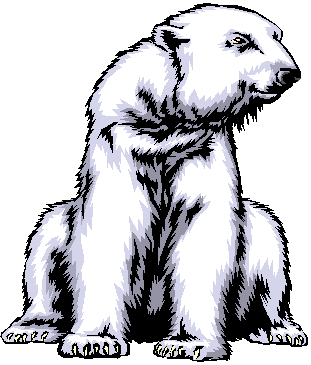|
  
|
|
Domain-Eukarya
|
|
U. Maritimus
is classified under the eukaryotic domain because it is a multi-cellular organism. The
cells that make up this organism contain a large variety of organelles.
Each cell is programmed to perform a specific task. All of the cells
communicate and work together to carry out daily activity.
|
|
Kingdom-Animalia
|
|
There are several distinct
characteristics which place the polar bear in the animal kingdom.
Polar bears, like all other animals are eukaryotic, multi-cellular
organisms. They are heterotrophic, meaning that they get their
food and energy from consuming other organisms. Animals also
lack cell walls and are motile. |
|
Phylum-Chordata
|
|
Polar bears are placed in the
phylum chordata because they, like all other chordates, develop a notochord
or "back-string" during the early stages of embryonic development. The
notochord is a rod-like structure, composed of connective tissue (Gotch,
26). Furthermore, all chordates have a dorsal tubular nerve chord,
pharyngeal pouches, an endostyle and a postanal tail. The
dorsal nerve chord is derived from the ectoderm; whereas, the
notochord is derived from the endoderm. The endostyle secretes
mucus and proteins which are rich in iodine. In addition,
chordates are bilaterally symmetrical, meaning that they face the
environment in only one direction. Polar bears have an
increased complexity as well as an enhanced nervous system. |
|
Subphylum-Vertebrata
|
|
U.
Maritimus
is one of 43,000 species included in the subphylum vertebrata (Gotch, 27).
All vertebrates share a unique set of joints located laterally down the
back; these joints are commonly known as vertebrate. Aside from the
cartilaginous fish, all mammals, reptiles, birds and amphibians, use a
notochord for support during early development. However, the notochord
is replaced by a bony spinal column. This
structure is made up of a number of vertebrates which are fused together and
connected to the remaining endoskeleton. |
|
Class-Mammalia
|
|
The polar bear
belongs in the class mammalia for 4 specific reasons; 1) it has true hair
and 2) the polar bear uses the mammary gland to produce milk for their young
3) polar bears have several different glands 4) they
undergo viviparity rather than oviparity-meaning that mother polar
bears retain the developing embryo inside until it is fully
developed
|
|
Subclass-Eutheria
|
|
Mammals
included in this subclass are known as the "typical" or "well-made"
animals. This subclass separates mammals by looking at the how
advanced their young are at the time of birth and the amount of parental
care their young will need after birth. Organisms that are
placed in this subclass give birth to young that have reached the
advanced state of development. However, these mammals are unable
to care for themselves after birth and are dependant on their mother.
The presence of a placenta is also a key characteristic among mammals of
the Eutheria subclass (Gotch, 460) |
|
Order-Carnivora
|
|
The order
carnivora is one of the 19 orders within the class mammalia. The
carnivores consist of lions, dogs, weasels, and their kin (Gotch, 33).
Organisms within the order carnivora eat meat as their primary food
source. |
|
Family-Ursidae
|
|
All
animals under the family ursidae are mammals and primarily consume
meat. Some common characteristics of bears under the family
ursidae include: short tail, an elongated body, great ability to
hear, good sense of smell and powerful claws used for predation. |
|
Genus-Ursus
|
|
The genus
ursus incldes all the bears most cosley related to the polar bear.
Those bears included in the genus ursus include U. Thibetanus, U.
Americanus, U. Malayanus, U. Maritimus, and U. Arctos |
|
Species-Ursus
Maritimus
|
|
Ursus Maritimus
is one of the three species within the genus Ursus. The polar bear
is known for living among the Arctic pack ice (Gotch, 588).
|